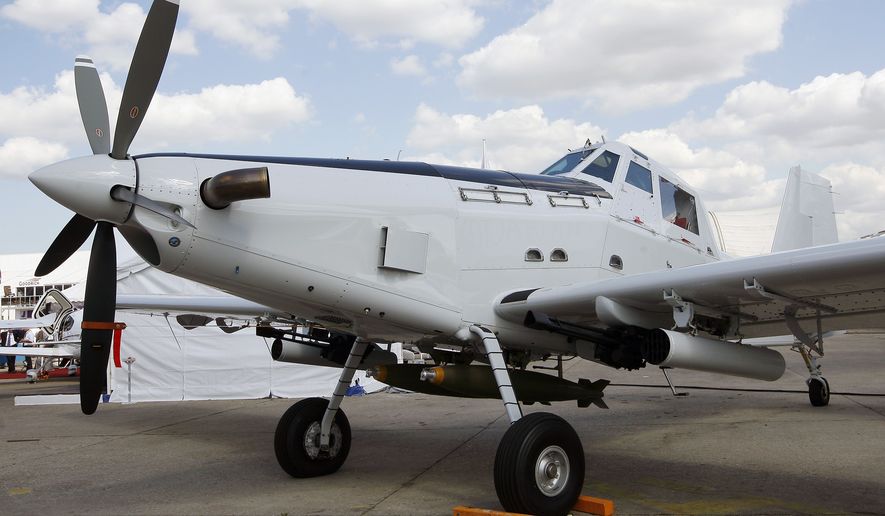It’s the ultimate in repurposing.
Pilots with U.S. Air Force Special Operations Command, trained to fly some of the most sophisticated, stealthy, high-tech planes ever built, will soon be going to war in modified, souped-up crop-dusters, the Pentagon says.
Instead of spraying fertilizer on a potato patch, the nimble aircraft will go after enemy troops on a battlefield or, more likely, terrorist groups operating in some of the world’s most forbidding combat zones.
In a choice that surprised many, the Pentagon picked the AT-802U Sky Warden, to be built by Florida-based L3Harris Technologies and Texas-based Air Tractor Inc., as its main light attack aircraft specifically designed to support special operations forces. The contract, initially $170 million, could reach $3 billion. It will provide up to 75 aircraft, associated spares and maintenance support as part of Special Operations Command’s Armed Overwatch program, officials said.
Pentagon officials say the fixed-wing Sky Warden, like the workhorse crop-duster, is designed to be versatile, durable and relatively inexpensive. The airframe comes from Air Tractor, which has built planes for farmers and firefighters. The military plane is targeted for operations such as monitoring terrorist groups in rough African terrain.
Air Tractor aircraft “were developed precisely to operate in austere environments with limited infrastructure,” Jim Hirsch, president of Air Tractor, said in a statement.
SEE ALSO: Austin picks Air Force Gen. Ryder as next Pentagon spokesman
“This rugged, sustainable platform will operate in permissive environments and austere conditions around the world to safeguard our special operations forces on the ground,” said Gen. Richard Clarke, head of U.S. Special Operations Command.
“Armed Overwatch answers a critical need for U.S. Special Operations Command to conduct a wide range of operations globally in support of the national defense strategy,” he said.
The Armed Overwatch program aims to procure low-cost, rugged aircraft that can accomplish various missions, including close air support, surveillance and reconnaissance of the battle zone. The State Department used a previous version of the AT-802 to spray herbicides on illicit drug fields abroad. Most of those planes have been given to allies.
The AT-802U Sky Warden is intended to reduce the need for several single-role aircraft, such as the AC-130 gunship or the A-10 Thunderbolt II tank buster. Lt. Gen. James Slife, head of Air Force Special Operations Command, said such an air stack can cost up to $150,000 an hour.
Using a multipurpose aircraft like the Sky Warden to loiter in a targeted area, and perhaps be exposed to hostile fire, can cost less than $10,000 per flight hour, Gen. Slife told an April hearing of the Senate Armed Services Committee.
“It is a much more efficient way to do that. Further, it allows us to push those platforms further forward into more austere areas where they can operate co-located with the ground teams that they are partnered with,” Gen. Slife said.
The military has spent well over a decade seeking a small, propeller-driven aircraft that could provide close support to troops on the ground. The last plane that at least partially met those requirements was the Douglas A-1 Skyraider, which was in service from 1946 to the early 1980s.
Questions ahead
Not everyone is sold on the choice that Special Operations Command announced last week.
Bradley Bowman, a former Army Black Hawk helicopter pilot now with the Foundation for the Defense of Democracies, said he is concerned about the aircraft’s survivability on the battlefield. The A-10 Thunderbolt II, one of the planes the Sky Warden is meant to replace, has a titanium armor “bathtub” around the cockpit.
“This thing will not do well in a nonpermissive environment,” said Mr. Bowman, senior director of the foundation’s Center on Military and Political Power. “What about the survivability of the pilot?”
He also questioned the carriage capacity of the Sky Warden and its maneuverability if laden with a full complement of armaments and support equipment.
“How does the loitering time and the range of that aircraft change when you load up the weapon systems?” Mr. Bowman asked. “Let’s get Special Operations what they need, but make sure it is the best thing that meets the mission.”
Some missions may require more firepower than the Sky Warden can provide, Gen. Slife acknowledged.
Still, “you can outfit the aircraft with a robust suite of sensors that will exceed what is available with most dedicated [intelligence, surveillance and reconnaissance] platforms today, or you can outfit the platform with a robust suite of precision munitions,” Gen. Slife said.
“The Armed Overwatch platform is not a panacea for every tactical situation that a ground force might find themselves in, but for what we envision … we think it is a prudent investment,” Gen. Slife said.
The companies that won the contracts expect to start turning out the fully modified Armed Overwatch aircraft next year at the L3Harris modification center in Tulsa, Oklahoma, after the initial production at Air Tractor’s plant about 100 miles northwest of Fort Worth, Texas.
• Mike Glenn can be reached at mglenn@washingtontimes.com.




Please read our comment policy before commenting.